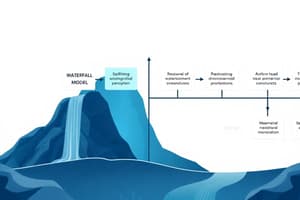Podcast
Questions and Answers
What is the advantage of RAD model in accommodating changing requirements?
What is the advantage of RAD model in accommodating changing requirements?
Changing requirements can be accommodated
What type of projects is the V-model suitable for?
What type of projects is the V-model suitable for?
Smaller projects where requirements are very well understood
What is a limitation of the RAD model?
What is a limitation of the RAD model?
Requires highly skilled developers/designers
What is the characteristic of the V-model SDLC?
What is the characteristic of the V-model SDLC?
What is the benefit of the V-model in terms of management?
What is the benefit of the V-model in terms of management?
What type of projects is the RAD model suitable for?
What type of projects is the RAD model suitable for?
What is a limitation of the V-model?
What is a limitation of the V-model?
What is the role of customer feedback in the RAD model?
What is the role of customer feedback in the RAD model?
What is the characteristic of the RAD model in terms of component reusability?
What is the characteristic of the RAD model in terms of component reusability?
What is the limitation of the V-model in terms of working software?
What is the limitation of the V-model in terms of working software?
Flashcards are hidden until you start studying
Study Notes
Iterative Model
- Combines the sequential steps of the traditional Waterfall Model with the flexibility of iterative design
- Allows for improvements and changes to be made at each stage of the development process
- Development begins by specifying and implementing just part of the software, which is then reviewed to identify further requirements
- The process is then repeated, producing a new version of the software at the end of each iteration of the model
Advantages of Iterative Model
- Some working functionality can be developed quickly and early in the life cycle
- Results are obtained early and periodically
- Testing and debugging during smaller iteration is easy
- Easier to manage, high risk part is done first
- Software is produced early which facilitates customer evaluation and feedback
Disadvantages of Iterative Model
- More resources may be required
- More management attention is required
- Management proximity is more
- Not suitable for smaller projects
Spiral Model
- Provides support for Risk Handling
- Diagrammatic representation looks like a spiral with many loops
- Each loop of the spiral is called a Phase of the software development process
SDLC Models
- Types of SDLC models: Waterfall, Rad, V-shaped, Incremental, Iterative, Big Bang
Waterfall Model
- Continuous software development model in which development is seen as flowing steadily downwards (like a waterfall) through the steps of requirements analysis, design, implementation, testing, integration, and maintenance
- Also referred to as linear-sequential life cycle model
Advantages of Waterfall Model
- Simple, easy to understand and use
- Phases are processed and completed one at a time
- Works well for smaller projects where requirements are very well understood
- Process and results are well documented
Disadvantages of Waterfall Model
- No working software is produced until late during the life cycle
- High amounts of risks and uncertainty
- Poor model for long and ongoing projects
- Not suitable for projects where requirements are at high risk of changing
RAD (Rapid Application Development) Model
- Uses minimal planning in favor of rapid prototyping
- Focuses on gathering customer requirements through workshops or focus groups, early testing of the prototypes by the customer using iterative concept, reuse of the existing prototypes (components), continuous integration and rapid delivery
Advantages of RAD Model
- Changing requirements can be accommodated
- Reduced development time
- Increase reusability of components
- Quick initial reviews occur
- Encourages customer feedback
- Suitable for projects requiring shorter development times
Disadvantages of RAD Model
- Dependency on technically strong team members for identifying business requirements
- Only system that can be modularized can be built using RAD
- Requires highly skilled developers/designers
- Requires user involvement throughout the life cycle
V-Model
- SDLC model where process executes in a sequential manner in V-shape
- Also known as Verification and Validation model
- Based on the association of a testing phase for each corresponding development stage
Advantages of V-Model
- Highly-discipline model and phases are completed one at a time
- Works well for smaller projects where requirements are very well understood
- Easy to manage due to the rigidity of the mode
- Each phase has specific review process
Disadvantages of V-Model
- Not a good model for complex projects
- Poor model for long and ongoing projects
- Not suitable for projects where requirements are at high risk of changing
- No working software is produced until late during the life cycle
Studying That Suits You
Use AI to generate personalized quizzes and flashcards to suit your learning preferences.




